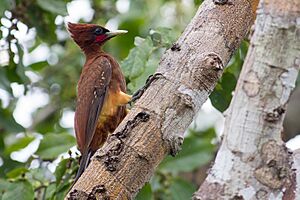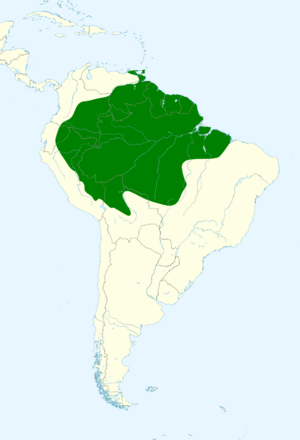Chestnut woodpecker facts for kids
Quick facts for kids Chestnut woodpecker |
|
|---|---|
 |
|
| Conservation status | |
| Scientific classification | |
| Genus: |
Celeus
|
| Species: |
elegans
|
| Subspecies | |
|
see text |
|
 |
|
The chestnut woodpecker (Celeus elegans) is a cool bird from the woodpecker family. You can find it on the island of Trinidad and in most countries in South America. It lives in places like Venezuela, Brazil, Colombia, and Peru.
Contents
Meet the Chestnut Woodpecker Family
Scientists group animals into different types. The chestnut woodpecker has six main types, called subspecies. Think of them like different cousins in the same family! Each one has a slightly different look or lives in a different area.
Here are their scientific names:
- C. e. hellmayri
- C. e. deltanus
- C. e. leotaudi
- C. e. elegans
- C. e. citreopygius
- C. e. jumanus
Some scientists are still studying if two of these types, citreopygius and jumanus, might be more like another woodpecker species. It's like a big puzzle they are still solving!
What Does a Chestnut Woodpecker Look Like?
The chestnut woodpecker is about 26 to 32 centimeters (10 to 13 inches) long. That's about the length of a ruler! They weigh between 93 and 168 grams (3.3 to 5.9 ounces).
Boys (males) of all types have a bright red patch on their cheek. Girls (females) do not have this red patch.
Most chestnut woodpeckers have a creamy-colored forehead and a cool crest on their head. The rest of their head, including their chin and throat, is a deep brown color. Their back and upper parts are a rich reddish-brown. Their flight feathers are dark brown with some reddish bars. Their tail feathers are dark, sometimes with a bit of red on the outer ones.
Their belly and chest are dark brown. Their sides are a lighter, creamy color. Their beak is usually ivory, yellow, or greenish-yellow. Their eyes are reddish-brown, and their legs are olive or dark gray. Young woodpeckers look a lot like the adults but might have a darker face.
Some of the different types of chestnut woodpeckers have slight color differences. For example, some are a bit darker overall, while others might be paler or have more spots on their wings.
Where Do Chestnut Woodpeckers Live?
These woodpeckers live in many different parts of South America and on Trinidad. Each of the six types lives in a specific area:
- C. e. hellmayri lives in eastern Venezuela, Guyana, and parts of Brazil.
- C. e. deltanus is found in northeastern Venezuela.
- C. e. leotaudi lives on the island of Trinidad.
- C. e. elegans is found in eastern Suriname, French Guiana, and northern Brazil.
- C. e. citreopygius lives in eastern Ecuador and eastern Peru.
- C. e. jumanus ranges from eastern Colombia and southern Venezuela down into northern Bolivia.
They like to live inside and at the edges of thick or lighter forests. You can find them in different kinds of forests, including those that flood sometimes. They also live in forests that are growing back and even in cocoa plantations. They usually live from sea level up to about 1,000 meters (3,300 feet) high, depending on the country.
How Do Chestnut Woodpeckers Behave?
Staying Put
The chestnut woodpecker doesn't travel far. It stays in the same area all year long.
What Do They Eat?
These woodpeckers love to eat ants and termites! They also enjoy fly larvae and some fruit. They usually look for food alone, in pairs, or in small groups. Sometimes, they even join other bird species to hunt for food together.
They mostly search for food on tree trunks and big branches, from the lower parts of trees up to the middle sections. They find their prey by picking it off trees or by breaking open termite nests built on trees.
Building a Home and Raising Chicks
Chestnut woodpeckers lay eggs in April and May in Trinidad and French Guiana. In other places, like Venezuela and Brazil, they might breed earlier in the year.
They make their nests by digging a hole in a dead tree or a tree stump. A female woodpecker usually lays three eggs. We don't know exactly how long the eggs take to hatch or when the baby birds leave the nest.
Sounds They Make
The chestnut woodpecker has some interesting calls! Its main call sounds like a "wewa ew-ew-ew-ew-ew-ew" going down in pitch. It also makes "rattling screeches" and a "mellow 'gwarrr'". Sometimes, you might hear a "wick-wick-wick-wick-wick" or a "nasal 'kyeenh'".
Both male and female woodpeckers drum on trees. Their drum sound is a quick "dop-dop." They do this often and loudly during the breeding season.
Are They Safe?
The IUCN (a group that checks on animals) says the chestnut woodpecker is a "least-concern species." This means they are not in danger of disappearing right now.
They live in a very large area. Even though we don't know exactly how many there are, their numbers seem to be going down a bit. But there are no big threats to them right now. You can find them in many protected areas, which helps keep them safe.


